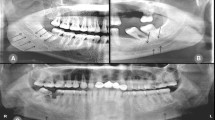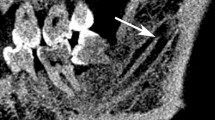Abstract
Purpose
The present study aims to estimate the prevalence of bifid mandibular canals in patients treated at the Dental Clinic of the Federal University of Paraná, Brazil.
Methods
The sample consisted of 3,024 panoramic radiographs from male (n = 1,155) and female (n = 1,869) patients (mean age 30 years). An experienced radiologist analyzed the panoramic radiographs according to the study of Langlais et al. (J Am Dental Assoc 110:923–926, 1985), which classifies bifid mandibular canals into four different types.
Results
Sixty patients (1.98 %) presented bifid mandibular canals. Specifically, 50 patients revealed bifid mandibular canals type I, while 10 patients revealed bifid mandibular canals type II. All the variations were unilateral. In addition, statistically significant results were not observed for gender distribution.
Conclusion
The present findings indicate a low prevalence of morphologic alterations of the mandibular canal in the studied population. However, the present outcome highlights the clinical relevance of investigating the radiologic morphology of the mandibular canal prior to surgical interventions.



Similar content being viewed by others
References
Auluck A, Pai KM, Mupparapu M (2007) Multiple mandibular nerve canals: radiographic observations and clinical relevance—report of 6 cases. Quintessence Int 38:781–787
Devito KL, Tamburus JR (2001) Anatomy of the mandibular canal: radiographic classification of variations. Rev APCD 55:261–266
Grover PS, Lorton L (1983) Bifid mandibular nerve as a possible cause of inadequate anesthesia in the mandible. J Oral Maxillofac Surg 41:177–179
Heasman PA (1988) Variation in the position of the inferior dental canal and its significance to restorative dentistry. J Dent 16:36–39
Kiersch TA, Jordan JE (1973) Duplication of the mandibular canal. Oral Surg Oral Med Oral Pathol 35:133–134
Klinge B, Petersson A, Maly P (1989) Location of the mandibular canal: comparison of macroscopic findings, conventional radiography, and computed tomography. Int J Oral Maxillofac Impl 4:327–332
Langlais RP, Broadus R, Glass BJ (1985) Bifid mandibular canals in panoramic radiographs. J Am Dental Assoc 110:923–926
Mardinger O, Chaushu G, Arensburg B, Taicher S, Kaffe I (2000) Anatomic and radiologic course of the mandibular incisive canal. Surg Radiol Anat 22:157–161
Miloglu O, Yilmaz AB, Caglayan F (2009) Bilateral bifid mandibular canal: a case report. Med Oral Patol Oral Cir Bucal 14:244–246
Nikzad S, Azari A, Sabouri S (2008) Double mandibular foramina and canal: report of a case with interactive CT-based planning software. Iran J Radiol 5:83–86
Nortjé CJ, Farman AG, Grotepass FW (1977) Variations in the normal anatomy of the inferior dental (mandibular) canal: a retrospective study of panoramic radiographs from 3612 routine dental patients. Br J Oral Surg 15:55–63
Oliveira-Santos C, Souza PH, Berti-Couto SA, Stinkens L, Moyaert K, Rubira-Bullen IR, Jacobs R (2012) Assessment of variations of the mandibular canal through cone beam computed tomography. Clin Oral Investig 16:387–393
Patterson JE, Funke FW (1973) Bifid inferior alveolar canal. Oral Surg 36:287–288
Rossi PM, Brücker MR, Rockenbach MIB (2009) Canais da mandíbula bifurcados: análise em radiografias panorâmicas. Rev Cienc Med 18:99–104
Sanchis JM, Peñarrocha M, Soler F (2003) Bifid mandibular canal. J Oral Maxillofac Surg 61:422–424
Sonick M, Abrahams J, Faiella RA (1994) A comparison of the accuracy of periapical, panoramic, and computerized tomographic radiograph s in locating the mandibular canal. Int J Oral Maxillofac Impl 9:455–460
Takahashi A, Watanabe H, Kamiyama Y, Honda E, Sumi Y, Kurabayashi T (2013) Localizing the mandibular canal on dental CT reformatted images: usefulness of panoramic views. Surg Radiol Anat 35:803–809
Valarelli TP (2007) Radiographic interpretation of the mandibular canal in panoramic radiographs. Rev Aca Tir Odo 7:432–449
Wadhwani P, Mathur RM, Kohli M, Sahu R (2008) Mandibular canal variant: a case report. J Oral Pathol Med 37:122–124
Wyatt WM (1996) Accessory mandibular canal: literature review and presentation of an additional variant. Quintessence Int 27:111–113
Acknowledgments
We acknowledge Dr. Evelyn Louise Antonio for supporting the data selection during the present study.
Ethical standards
The present research complies with the current ethical laws of the country in which it was performed.
Conflict of interest
The authors declare that they have no conflict of interest.
Author information
Authors and Affiliations
Corresponding author
Rights and permissions
About this article
Cite this article
Kuczynski, A., Kucharski, W., Franco, A. et al. Prevalence of bifid mandibular canals in panoramic radiographs: a maxillofacial surgical scope. Surg Radiol Anat 36, 847–850 (2014). https://doi.org/10.1007/s00276-014-1298-2
Received:
Accepted:
Published:
Issue Date:
DOI: https://doi.org/10.1007/s00276-014-1298-2




